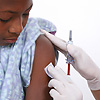
Updating a child's immunizations is an annual back-to-school rite of passage for all parents, but immunizations have been changing, and this year is no different.
The American Academy of Pediatrics traditionally has recommended that children receive nine vaccines for 13 primary childhood diseases. But UCSF pediatrician William DeGoff, MD, said that young children may get a break and receive one less shot this year.
"Rather than having to do MMR [measles, mumps and rubella] and varicella in two different shots they can be given in one combined shot. That's new this year, and that saves a needlestick, which is what most little kids care about," said DeGoff, a clinical professor of pediatrics.
"For kids under 12, they've only been doing one dose of varicella vaccine, but they're probably going to be doing two doses in the near future. This will provide the additional immunity," he said, because the varicella vaccine has been only about 70 percent to 80 percent effective.
Whether or not children receive a combined MMR and varicella vaccine will depend upon which versions of the inoculations their health care professional is using, he said.
The new HPV or human papillomavirus vaccine is being recommended for girls 11 and 12 years old, to prevent cervical cancer, precancerous genital lesions, and genital warts due to HPV. The vaccine, called Gardasil, gives protection against four different strains of the HPV.
The inoculation is administered in a series of three injections over a six-month period. The second and third doses should be given at two and six months (respectively) after the first dose. HPV vaccine may be given at the same time as other vaccines.
"Studies have shown that this vaccine will have a phenomenal benefit to society, saving lives and saving a lot of money in the long run, even though right now the vaccines themselves are expensive," DeGoff said.
Another vaccine that is in the offing, DeGoff said, is one that will immunize children against rotavirus, a viral infection that can cause severe diarrhea, vomiting, fever and dehydration (gastroenteritis) in infants and young children. The availability of the rotavirus vaccine is imminent, he said.
"The virus is the main reason why kids vomit and get dehydrated, and is a major cause of dehydration and death in Third-World countries," he explained. The vaccine will be administered at 2, 4 and 6 months of age.
The
nine traditional vaccines are: - •
"
DTaP, which combines vaccines against three diseases, diphtheria, tetanus
and pertussis, into one shot. Children need five DTaP shots for maximum
protection. The first three shots are given at 2, 4 and 6 months of
age. The fourth booster shot is given between 15 and 18 months, and
a fifth shot - another booster - is given when a child enters school,
at 4 to 6 years. "
- •
Hepatitis A vaccine is 94 percent to 100 percent effective in preventing
hepatitis A. Children between 12 and 23 months of age should receive
the two-time vaccine, administered at least six months apart. "
- •
Three doses of hepatitis B vaccine are needed for full protection from
the disease. The first dose is usually given at birth. This is particularly
important for children whose mothers are chronically infected. For other
babies, the first dose can be given between birth and 2 months of age.
The second dose is recommended at 1 to 4 months, and the third at 6
to18 months. These three doses should protect children for life. "
- •
Children should get either three or four doses of the Hib, or Haemophilus
influenza type b vaccine. The vaccine is recommended at 2, 4, 6 and
12 to 15 months of age (the 6-month dose is not given with one brand
of vaccine). "
- •
One dose of the influenza vaccine is recommended annually, beginning
around October or November. For children younger than 9 who are getting
influenza vaccine for the first time, two doses are recommended, at
least a month apart, depending on the type of vaccine. "
- •
The MMR combines vaccines for measles, mumps and rubella into one shot.
Most children who get the vaccine develop immunity to all three diseases,
and protection is believed to be lifelong. Two doses of vaccine are
recommended, with the first dose given at 12 to15 months of age. The
second may be given four weeks after the first, but it is usually given
at 4 to 6 years. No boosters are needed. "
- •
Four doses of pneumococcal vaccine are recommended, at 2, 4, 6 and 12
to15 months of age. Children who are late starting the series may need
fewer doses. Children 5 years old and older usually should not get pneumococcal
conjugate vaccine. But some older children (those with certain chronic
diseases or damaged immune systems) should still get a pneumococcal
vaccine. There is a different vaccine - called pneumococcal polysaccharide
vaccine - that can be given to these children and to adults. "
- •
Children should get four doses of polio vaccine, the first three doses
at 2, 4, and 6 to18 months of age, and a booster dose at 4 to 6 years.
"
- •
The separate varicella vaccine prevents chicken pox in 70 percent to
80 percent of people who receive it, and is expected to provide lifelong
immunity. A single dose of the vaccine currently is recommended for
children at 12 to 18 months of age, usually at the same time as the
MMR vaccine. Children who miss this shot can still get a single dose
of the vaccine until their 13th birthday. After the 13th birthday, two
doses are recommended, given four to eight weeks apart.
|

